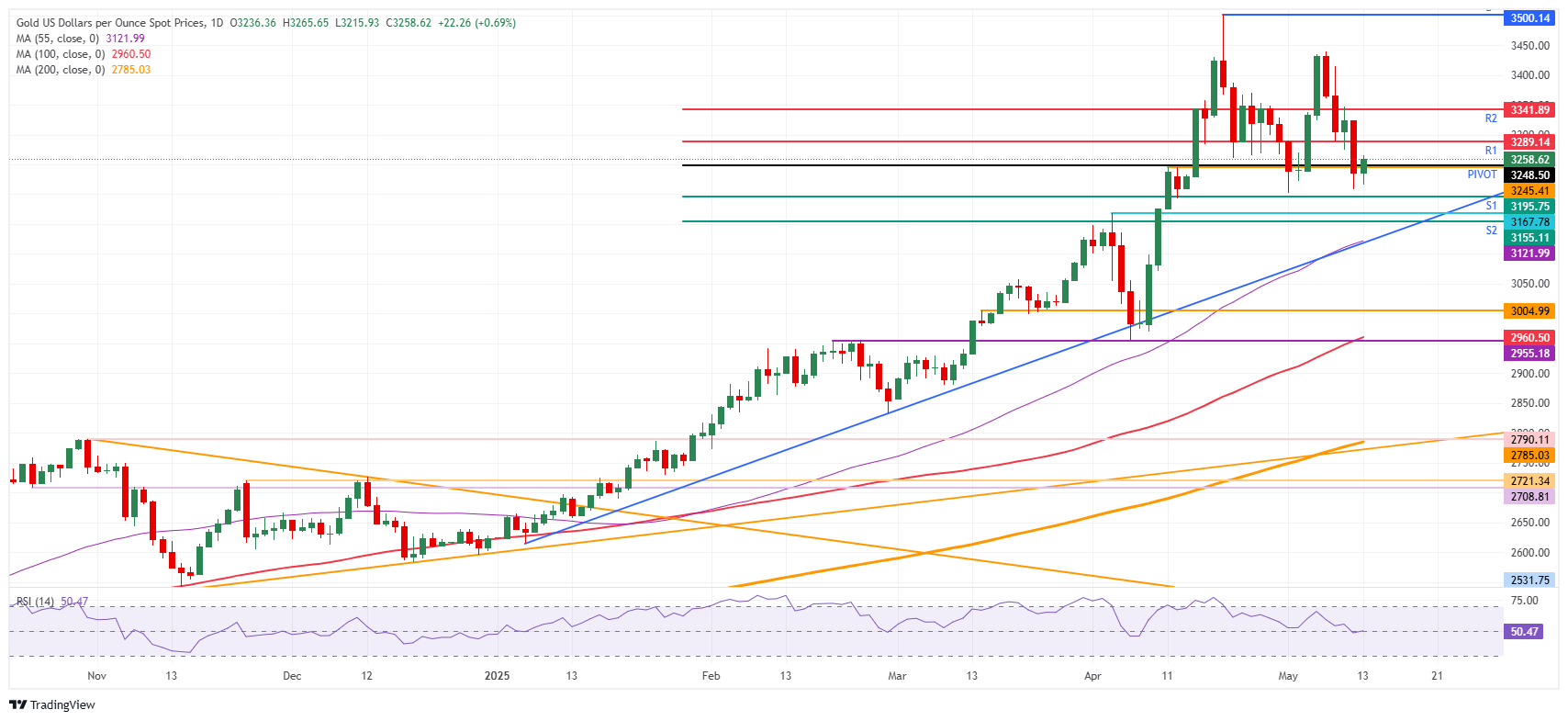- Gold price jumps over 0.5% on Tuesday as the US-China trade deal euphoria quickly fades.
- Traders become wary as no details are provided on the content of current deals with the UK and China.
- Traders are picking up some safe haven protection at current discounted prices.
Gold (XAU/USD) rebounds and trades near $3,255 at the time of writing on Tuesday, recovering parts from the 2.65% correction that took place on Monday after the US-China trade deal was announced. Traders are starting to get wary about the lack of detail in the announcement, and another flare-up could propel bullion back toward the record high set last month. Thus, the current move in the precious metal price might be a good time to buy the dip.
“The devil is in the details during negotiations,” said Christopher Wong, a strategist from Oversea-Chinese Banking Corp. “Some degree of caution remains warranted, as we see consolidation in the range of $3,150 to $3,350 an ounce.”, Bloomberg reports. Meanwhile, Federal Reserve (Fed) Bank President of Chicago Austan Goolsbee warned that even current tariff levels will still have an inflationary impulse, the New York Times reports, while Deutsche Bank issued a report saying that the easing of China trade will not fuel a quick Fed interest rate cut.
Daily digest market movers: Fed is not going to rush in to help
- For the Perth-based mining company Northern Star, getting the equipment and materials needed to run a Gold mine in a remote part of Alaska was already costly. US President Donald Trump’s trade war isn’t helping, and sees its Pogo mine venture flirting with becoming break-even or even at a loss if tariff relief is not coming soon, Bloomberg reports.
- On Monday, President Trump said the US has the upper hand in its trade discussions with the European Union. “The European Union is in many ways nastier than China. We’ve just started with them. We have all the cards. They treated us very unfairly,” Trump said at the White House.
- A big drop in US-China trade barriers lessens the prospects of a serious inflationary supply crunch. Even so, inflation remains stubborn enough that the Fed probably still won’t be in a rush to cut interest rates, economists at Deutsche Bank write. Despite the trade war’s easing, “policies are likely to keep inflation at uncomfortably high levels for the Fed,” Deutsche’s team suggests. “This announcement therefore reinforces our view that the Fed is going to be slow to cut rates this year.” Deutsche’s baseline assumption is that the Fed’s next rate cut won’t come before December, Deutsche Bank reports in a Monday brief. Gold and US interest rates have an inverse relationship where lower rates often support a higher Gold price and vice versa.
Gold Price Technical Analysis: Build up slowly
“Close but no cigar”, it seems for President Trump again. Several traders and analysts are wary of the conceived trade deal with China, which is only a 90-day relief. Besides reducing tariffs for 90 days, there are no fundamental elements for markets to cling to, such as forward dates for negotiations, topics, additional numbers, or anything material to see a continuation of momentum. It makes sense for experienced traders to remain cautious and buy securities such as Gold after Monday’s correction.
The daily Pivot Point at $3,248 roughly coincides with that technical pivotal level at $3,245, the April 11 high, identified in previous weeks. From here on out, it would be healthy to see if Gold bulls can push the price back up to $3,289, the R1 resistance for this Tuesday. Further up, $3,341 might be a stretch, though it would mean a test of Friday’s high and the R2 resistance.
On the downside, a double bottom is getting formed near $3,195, which coincides with the S1 intraday support. From there, the next pivotal technical level comes into play at $3,167 (April 3 high), just ahead of the S2 support at $3,155. In case those two levels snap under pressure, the 55-day Simple Moving Average (SMA) comes into play at $3,121.

XAU/USD: Daily Chart
US-China Trade War FAQs
Generally speaking, a trade war is an economic conflict between two or more countries due to extreme protectionism on one end. It implies the creation of trade barriers, such as tariffs, which result in counter-barriers, escalating import costs, and hence the cost of living.
An economic conflict between the United States (US) and China began early in 2018, when President Donald Trump set trade barriers on China, claiming unfair commercial practices and intellectual property theft from the Asian giant. China took retaliatory action, imposing tariffs on multiple US goods, such as automobiles and soybeans. Tensions escalated until the two countries signed the US-China Phase One trade deal in January 2020. The agreement required structural reforms and other changes to China’s economic and trade regime and pretended to restore stability and trust between the two nations. However, the Coronavirus pandemic took the focus out of the conflict. Yet, it is worth mentioning that President Joe Biden, who took office after Trump, kept tariffs in place and even added some additional levies.
The return of Donald Trump to the White House as the 47th US President has sparked a fresh wave of tensions between the two countries. During the 2024 election campaign, Trump pledged to impose 60% tariffs on China once he returned to office, which he did on January 20, 2025. With Trump back, the US-China trade war is meant to resume where it was left, with tit-for-tat policies affecting the global economic landscape amid disruptions in global supply chains, resulting in a reduction in spending, particularly investment, and directly feeding into the Consumer Price Index inflation.